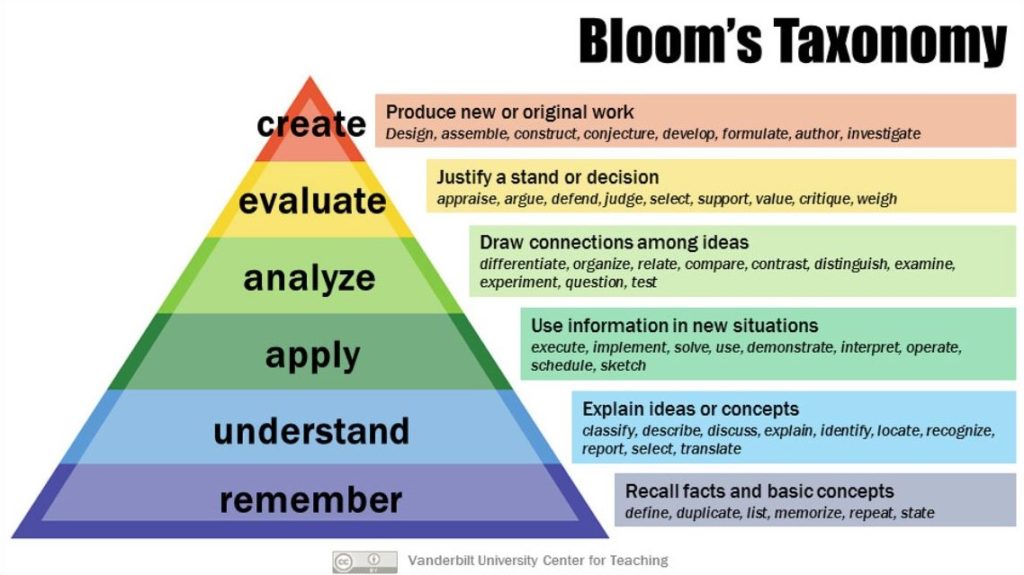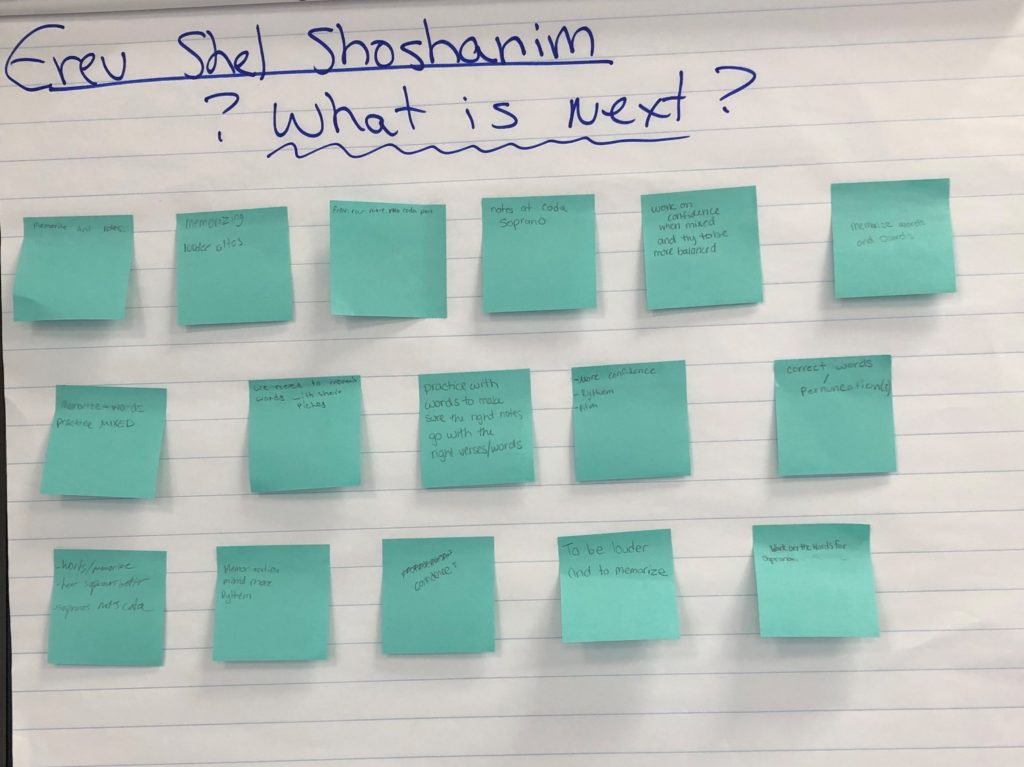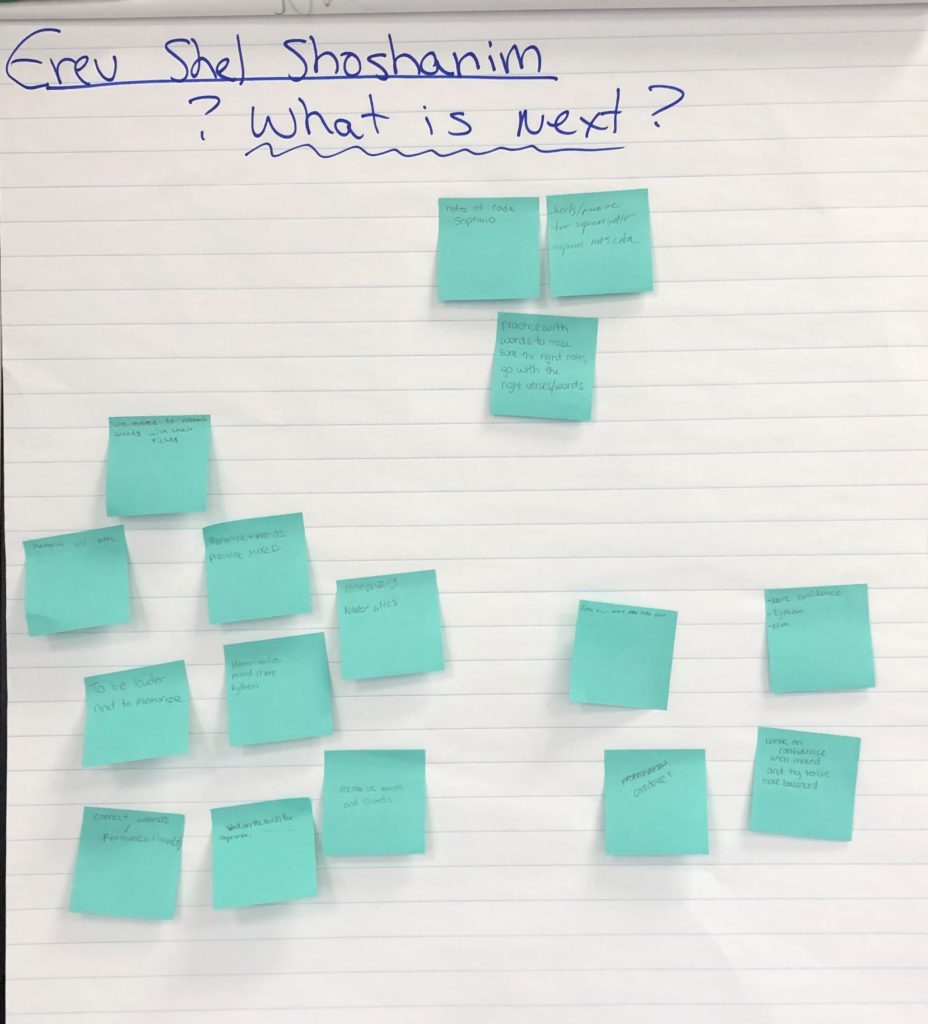
They can be used once a week, when a choir starts learning a new song, or just before an adjudicated choral music festival. They are a quick and effective instructional and assessment tool appropriate for the upper Elementary Choir through the Collegiate Honor Ensemble. They can be designed using Bloom’s Taxonomy of Educational Objectives, aligned with the National Core Arts Standards, and enhance your professional practice and teaching philosophy. They are invaluable but seen as superfluous.
To be honest, I did not use Exit Tickets (aka Ticket Out the Door, One Minute Essay, or Exit Slips) for over twenty-four years. I saw no need. Within a choir rehearsal or general music class, I continually and in real-time assess, adjust, and modify my instruction for the students. Music instruction and performances inherently activate and encompass all formative assessment components, so why take up valuable rehearsal time with documentation?
Reflection-in-Action
In Educating the Reflective Practitioner, Donald Schon calls the dynamic interplay through which “our thinking serves to reshape what we are doing while we are doing it” reflection-in-action (1987, p. 26). Most times, reflection-in-action occurs so naturally in the music classroom (like riding a bike) that we forget about the interacting skills and techniques that merge and allow us to shape and respond to our musical experiences (like balance, steering, and peddling). We use and understand this dynamic, but do our students? To help our students become more independent and our ensembles more responsive, we must consciously label, reinforce, and support reflection-in-action in the classroom.
I use Exit Tickets in my classroom because it keeps my choirs cognitively on their toes and fosters rehearsal awareness. It encourages choir members to become cognizant of the rehearsal experience and responsible for describing and assessing what they have learned. Using Exit Tickets reminds students that they just participated in a learning experience and asks, what did you learn? Or, “What strategies did we just use that helped us succeed today“?
Reflection-on-Action
Schon calls the second question, Reflection-on-Action. “We may reflect-on-action, thinking back on what we have done in order to discover how our knowing-in-action may have contributed to an unexpected outcome” (1987, p. 26). The rewards of Reflection-in-Action and the necessity of Reflection-on-Action helps students become aware of and uncover the dynamic relationship between a musical performance and its corresponding preparation. The product of music education becomes the learning process, and its application to making music becomes the focus.
Exit Tickets for Erev Shel Shoshanim (Evening of Roses) – arr. Jack Klebanow Messiah College Concert Choir
Traditional Exit Tickets
The research and professional writings that support formative assessment and Exit Tickets are extensive and well documented. Traditional Exit Tickets are not graded and can:
Encourage students to take stock in their learning
Provide descriptive feedback and actionable data for teachers
Help students identify problems, think critically, and contemplate solutions
Encourage all students, shy and boisterous, to participate and reflect on their learning
Exit Tickets’ Effect on Engagement and Concept Attainment in High School Science
Exit tickets motivated students to pay closer attention and increased behavioral engagement among typically engaged and disengaged students (Discussion, p.98).
The Classroom is Alive with the Sound of Thinking: The Power of the Exit Slip
Written student reflections are a vehicle for content review, aides absorbing new material, encourages divergent thinking, provides a safe way for students to ask for clarification, promotes self-expression, and fosters the ownership of ideas (Conclusion, p. 195).
Exit Tickets’ Effect on Engagement in College Classrooms
Exit tickets help students to be actively engaged in the learning process, encourages students’ connections to content and self-reflection, provides evidence of mastered content and challenges, and improves student behavior and academic achievement (Conclusion, p. 5917).
Exit Tickets are Teacher-Centered
As soon as I began using Traditional Exit Tickets periodically in class, I noticed a shift in my thinking and ensembles musical abilities. My students became more engaged in the lesson, and our rehearsals grew to be more productive and enjoyable. For me, I came to realize that even though I covered a concept or presented a skill, that did not mean my students could transfer their new knowledge and apply it to new experiences. I found myself experiencing The Expert Blind Spot. Exit Tickets made this perfectly clear.
I soon discovered that using traditional Exit Tickets places the responsibility and ownership of learning and assessment away from the students and on to me, the teacher. The teacher presents a prompt, the students provide feedback, and the teacher adapts their instruction. The teacher – not the students – initiates higher-order thinking skills and evaluates, assesses, and modifies the learning. If we want high functioning, independent and interdependent student musicians, we must teach Ensemble –Centered Assessment.
Lesson Retrospectives and Ensemble-Centered Assessment
The purpose of a Lesson Retrospective is to provide the choir as a group the opportunity to initiate higher-order thinking skills through assessing, evaluating, and modifying their shared rehearsal and class experience. It builds upon the Exit Ticket format and requires the ensemble to discover challenges, generate insights, and create actionable items needed to move forward. By learning group formative assessment skills, students individually and collectively take ownership of their musical growth and the ensemble’s success.
A Lesson Retrospective is an educational modification of a Scrum team’s assessment, and planning meeting called a Sprint Retrospective. The purpose of a Sprint Retrospective is to provide a Sprint Group time after their independent work on a group project to come together and plan ways to increase the quality and effectiveness of their project. The Agile Development Instructional Framework incorporates the Scrum methodology and Agile Development principles and provides a clear outline of steps and skills in the rehearsal setting that facilitates active student and ensemble problem solving, collaboration, and accountability.
Sprint Retrospective Resources
7 Great Agile Sprint Retrospective Ideas
The Guide to Retrospectives – Remote or in Person
11 Ideas to Spice up Your Retrospective
6 Effective Sprint Retrospective Techniques
Sprint Retrospective Ideas
Fun Retrospectives: Activities and ideas for making agile retrospectives more engaging.
Lesson Retrospectives Prompts
In his work Art and Science of Teaching, The Many Uses of Exit Slips, Robert Marzano presents four types of prompts that focus on specific and intended outcomes.
1. Prompts that Provide Formative Assessment Data
“On a scale of 1 – 5, how would you rate your current level of understanding _____________?”
2. Prompts that Stimulates Student Self-Analysis, Self-Regulation
“What could you have done today to help yourself learn the material better?”
3. Prompts that Focus on Instructional Strategies
“How did your sprint group work today help you understand the music better?”
4. Prompts that are Open Communications to the Teacher
“What is something I could do to improve your understanding of ________________?”
Lesson Retrospectives Design
Lesson Retrospectives can range from a simple 1-5 rating scale, to facilitating autonomy and metacognition by designing prompts using Bloom’s Taxonomy Hierarchical Framework.

Remember – What interval/key signature/music term did we focus on today?
Understand – How do dynamics enrich our musical performances?
Apply – How did the major/minor scale relate to learning part of our song today?
Analyze – What was the rehearsal sequence we followed this afternoon?
Evaluate – Why did our rehearsal and learning this section of music go well (not go well) today?
Create – List three ways you/the choir can review, reinforce, or solidify what we accomplished today?
Leading Voices Blog Retrospect
Here is an example of using a Google Form as a digital Exit Ticket. If you have two minutes to spare, I would appreciate your thoughts and ideas about using Exit Tickets and Lesson Retrospectives in the Choral Classroom. Thank you for your time.
TL;DR – Fostering Individual and Ensemble Autonomy
In the music classroom and within the choral rehearsal, teachers know the value of a good lesson anticipatory set and the importance of effective vocal warmups. We dedicate a few minutes at the beginning of each rehearsal to release tension in the body and engage the breath, activate phonation and reinforce correct vocal placement, and support and strengthen good choral singing skills. But if we are not careful, we can miss supporting and warming up the most essential part of the singers’ voice, the musical mind.
Traditional Exit Tickets and Lesson Retrospectives are essential in mentally attracting and engaging students into the lesson and cultivating mindful presence in the rehearsal room. These ensemble-centered assessment strategies promote student and group reflection, provide authentic and actionable feedback, and foster individual and ensemble autonomy. They are short and quick activities you can integrate into your instruction that will transform your students’ musicianship and foster ensemble autonomy.
Try not to let the trauma from a Professional Day gone wrong or the educational jargon prevent you from researching and giving Exit Tickets and Lesson Retrospectives a try. I now agree with my principal, who sensed my skepticism (I mentally rolled my eyes) when he suggested I try Exit Tickets with my choirs and said:
“No, really . . . . they are well worth your time”.
Postlude
A lesson Study is a form of professional development where teachers collaboratively design research lessons and improve instruction using the evidence they have observed and gathered on learning and concept development. Lesson Retrospectives also uses this framework and provides our students the opportunity to design, implement, and assess learning experiences with their peers. Allowing students to participate in Reflection-on-Action offers educators the opportunity to step back, observe, and evaluate the students’ instructional modifications or adaptations.
Agile Development Instructional Framework Resources
All activities, rehearsal strategies, and projects developed through applying the Agile Development Instructional Framework are research-based. They contain elements of the following teaching models and instructional theories: Self-Regulated Learning, Self-Directed-Learning, Experiential Learning Theory, Understanding by Design, Cognitive Coaching, and the Universal Design for Learning.
References
ASCD. “Art and Science of Teaching, The Many Uses of Exit Slips.” The Many Uses of Exit Slips – Educational Leadership.
Fowler, K., Mark Windschitl, M., & and Richards, J. Understanding Students, Adapting Instruction, and Addressing Equity
Keeping Learning on Track: A Case-study of Formative Assessment Practice and its Impact on Learning in Meridian School District
Little, G. Faith, Exit Tickets as Formative Assessments
Sondergeld, T., Bell, C., Leusner, D. 2010. Understanding How Teachers Engage in Formative Assessment Project: Keeping Learning on
Track, Wiliam, D. 2006. Keeping Learning on Track: Formative Assessment and the Regulation of Learning






Leave a Reply
You must be logged in to post a comment.